|
 Dwight Peck's personal website Dwight Peck's personal website
Scenes of Bologna, 2014
The venerable city of porticos, towers, and canals in the springtime
Kristin's come up from Rome, I've come south from Switzerland, and miraculously we've managed to meet up as planned in the cavernous new very-subterranean tracks built below the existing Bologna train station for the high-velocity Milan-Salerno line. 25 May 2014.
    
You may not find this terribly rewarding unless you're included here, so this is a good time for casual and random browsers to turn back before they get too caught up in the sweep and majesty of the proceedings and can't let go.

I definitely should have got the exact details. But after dashing up and down the stairs, five minutes later we were staring at each other across 60 metres of empty new hall one floor up, and Bob's your uncle.
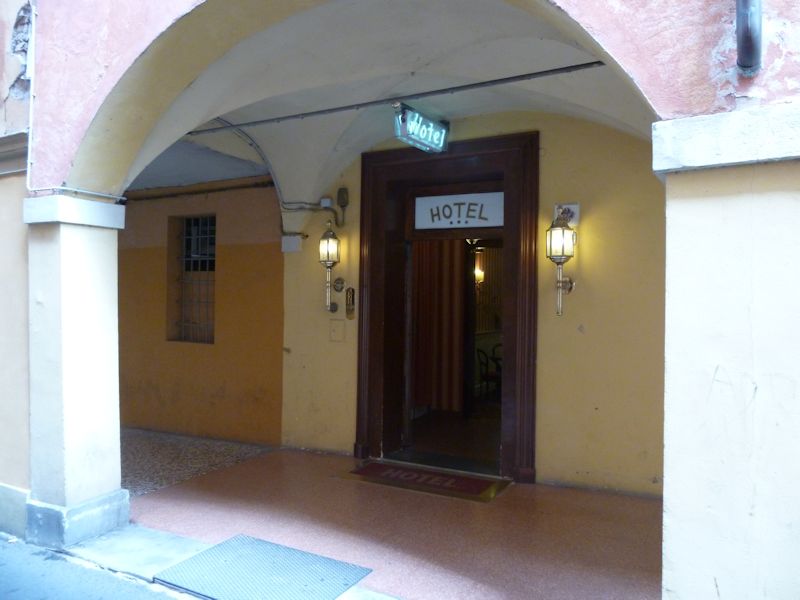
We're booked into the Zanhotel "Il Canale" -- very central, friendly, inexpensive, good breakfast, and altogether perfect except for one Big Problem: they assured us that there was Wifi in every room and unh-unh, no way, frustrated guests were squatting in the narrow lobby to get their e-mail.

But after one night in a beautiful, scenic, but unconnected room on the top floor, the nice people managed to move us to the only guest room on the ground floor, next to the reception desk and hung out over "Il Canale" itself, and we could not have been happier.

That sick-salmon colored projection off the right wall will soon be our new home, if we can make it through tonight without checking in to The Guardian, Gawker, TomDispatch, and the Talking Points Memo.
(Bologna is the 'city of canals'.)

The neighborhood is so safe and wholesome that even the German 'erotic boutique' chain next door is up-scale. (In fact, we were told that our hotel, prior to renovation, had most recently seen service as a bordello.)

Decompressing from our high-velocity train rides, we're out to reconnoitre. And locate the nearest wine shop.
(Bologna is the 'city of porticos'.)

The Duomo, Bologna's Cathedral of St Peter, just down the street (we'll be back for a more leisurely look inside).

In the meantime, a quick look at this overdressed kid with the huge hat will have to suffice.

'The city of porticos'

The city of very old buildings

We're on the Via Marsala, just parallel to our hotel on Via Bertiera.

The 15th-century Palazzo Grassi, with "crutch" style columns supporting the beams

Singapore Asian Fusion ("Sushi All You Can Eat")

Street scene: Via Marsala

The city of porticos

We emerge onto the Via dell'Indipendenza, the main north-south thoroughfare through the centre city, one block over from the hotel Il Canale.

Bologna, to a tourist, seems to be an astonishingly thriving city, beautiful, lively, extremely well managed, presumably with due credit to a half-century of communist and leftist city governments following World War II.

Now with about 400,000 worthy citizens of the city itself, and about 1 million in the metropolitan area, Bologna is the 7th largest city in Italy, and was recently ranked number one for 'quality of life' amongst the top 100 Italian cities.

The Piazza del 8 Agosto, a large square along the Via dell'Indipendenza and adjacent Park of Montagnola at the northern end of the historic centre, near the main rail station

A monument to the 8th of August 1848, commemorating the uprising in which the population briefly expelled the Austrian imperial garrison. In 1860, the city voted to join the Piedmontese Kingdom of Sardinia, along with other Italian properties that a year later (except for Venice and Rome) became unified as the Kingdom of Italy.

We're seeking the pinacoteca, the National Picture Gallery, and we thought we must be close (those are Canova sculptures), but turns out that this is just a branch of the university arts faculty.

Here's the art museum a bit farther along, but this being Italy, it's closed. We'll come back later.

The university district and the Via Belle Arti. The University of Bologna, founded in 1088 in some sense, is normally considered the first university in Europe, and both the city and the region are enormously proud of that. In the 12th and 13th centuries, deceased teachers were rewarded with elaborate funeral monuments showing them lecturing to rapt and sometimes dozing students (more on that later).

The Piazza Giuseppe Verdi: we're walking through the huge university district down the Via Zamboni towards the centre of the centre-city (but no zamboni ice machines here; it's named for Luigi Zamboni, a young 18th century patriot and designer of the Italian tricolor flag).
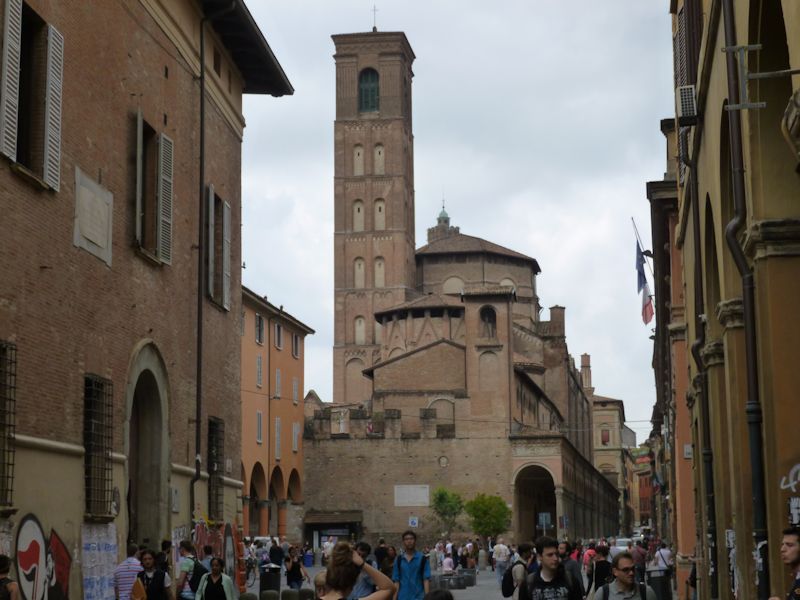
The Piazza Giuseppe Verdi and the back of the Basilica di San Giacomo Maggiore

Gone but not forgotten: a spray-painted memorial to Francesco Lorusso, who was shot by the authorities during demonstrations here in 1977

The Piazza G. Verdi again -- a student hangout

Progressing down the Via Zamboni along the side of the church of San Giacomo Maggiore

A backward glance at the university district. The historic centre of Bologna, mostly pedestrian or limited vehicle access, is said to be the second largest historic centre in Europe. The circumambient city walls were not demolished until the late 19th century.

The city of porticos

The Basilica di San Giacomo Maggiore was mostly built in the late 13th century and consecrated in 1344. In the 15th century, the Bentivoglio family (the closest thing Bologna seems to have had to a ruling dynasty like the Estes, Medicis, Colonna, Visconti, Sforzas, della Scalas, Malatestas, etc., etc.) built their family chapel here and more or less took it over.

The façade dates from 1295, but the four funerary cells in the front were added a few years later.

Burying your dead right out on the village square. The church is presently closed (this is Italy), so we'll put a tick in the guidebook and remember to come back tomorrow.

The city of towers. There were at one time in Bologna a bristling of 180 civic towers erected in the 12th and 13th centuries, largely the familiar family-owned defensive structures common in many Italian city states in the era of competing oligarchic clans. Here and elsewhere, most of them were destroyed with the arrival of more unified city governments, but in Bologna there are still 20 of them standing tall and proud or . . .

. . . leaning. The famous Due Torri, long of symbol of Bologna's historic past, still come as a huge shock up close. (Not that Kristin, right, is paying attention.)

Distinctly unsettling; surely the authorities have noticed already, but this isn't normal. Except in Pisa.

Hey, look up there. In the niche.

We've just been told that that is the Actual Madonna of San Luca, herownself, with the divine young fellow. In the city of 38 km of porticos, the longest one winds 4km up a nearby hill to the Sanctuary of the Madonna di San Luca, and annually since 1433 she and the young fellow have been paraded down during Ascension week, i.e., now; and our informant insists that these are they. But I'm doubtful . . .

. . . the posters all over town say she's supposed to be in the Duomo today. And then processing over to the Piazza Maggiore day after tomorrow.

Round the back of the Two Towers
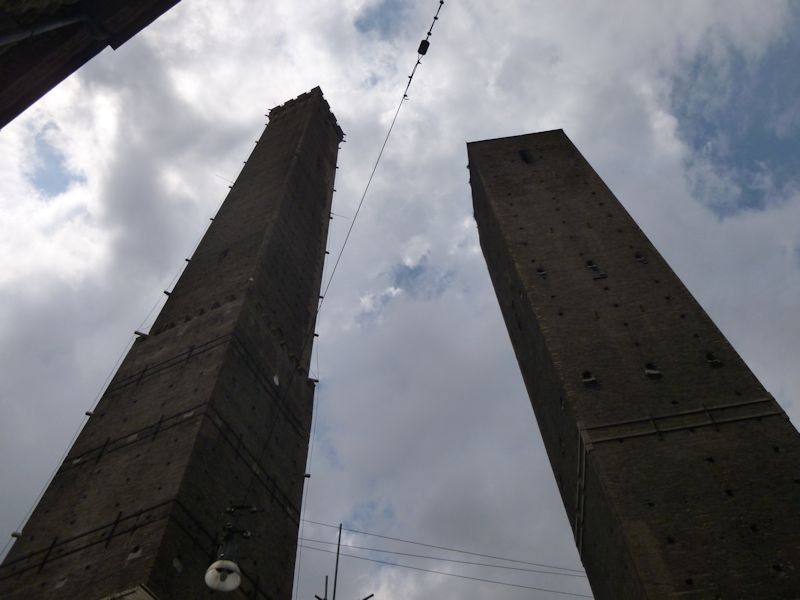
Convergence of the Twain (without the iceberg)

Solidarity with those arrested in the valley of Susa. The Italian and European authorites are drilling a monster new tunnel through the Alps for the super-high-speed train from Lyon to Turin, part of the European commercial trade network, and a lot of otherwise reasonable people fear that the valley of Susa will become as saturated with mile-long trucks and exhaust fumes as Courmayeur and the Mont Blanc tunnel from Chamonix to the Aosta valley. It's a Big Mess.
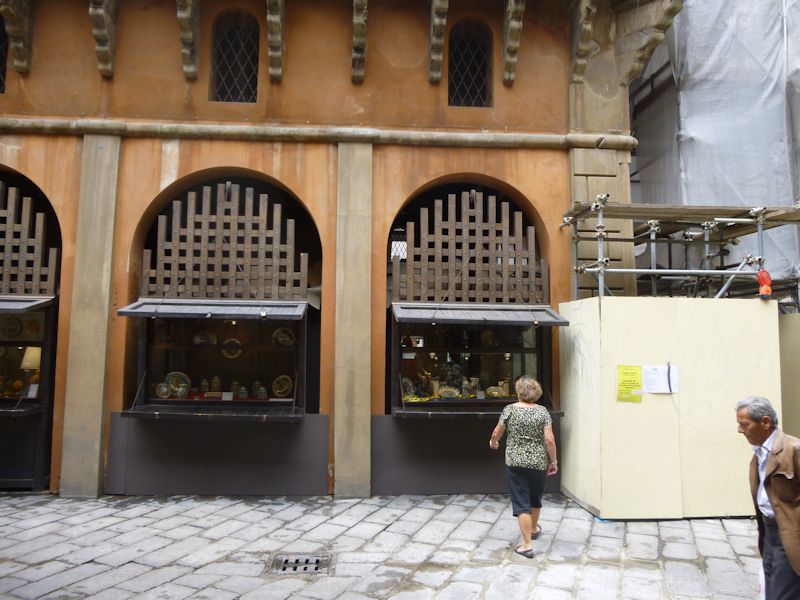
Kristin inspecting medieval market stalls in the base of one of the two towers

The Strada Maggiore (built over the original Roman Via Aemilia) and the Via Castiglione, near the Due Torri

Street scene (the city of porticos) -- the street layout is all quite grid-like, not because of Napoleonic rationalizations in 1796, still less of the 13th-14th century bastide era of the Languedoc, but because of the Roman coloniae city-plans oh so long ago.
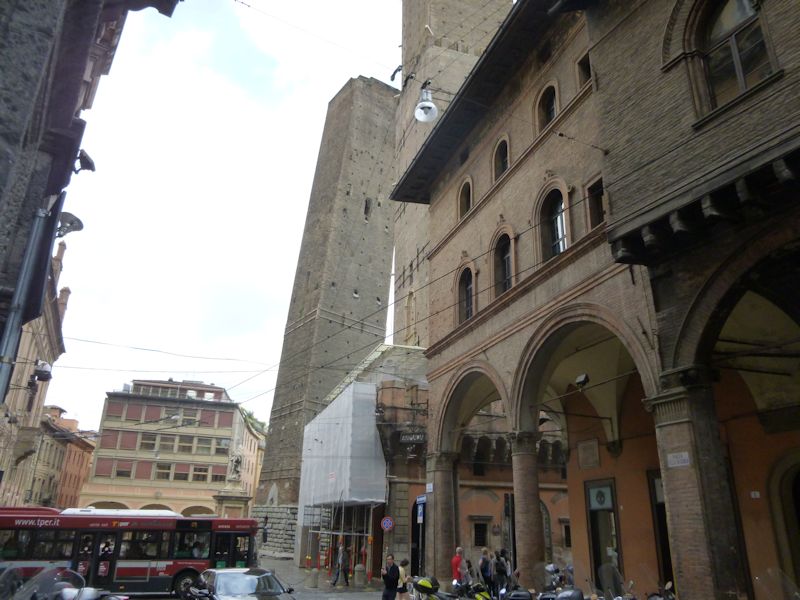
The Leaning Tower of Bologna . . . which no one seems to be very concerned about, so it must be okay.

The nearby Palazzo della Mercanzia -- the medieval Chamber of Commerce

The Palazzo del Podestà in the Piazza Maggiore, built in about 1200 -- the city hall, in effect, back when the podestà or 'chief magistrate' (lit: the power guy) ran the city. (The first use of the title of podestà was here in Bologna in 1151; Emperor Friedrich Barbarossa set them up all over northern Italy to communicate his wishes to the populace, and the name stuck.) And the Palazzo Re Enzo, added to it in 1245.

We're strolling aimlessly, admiring those sandwiches on the right.

Another prominent feature of the Piazza Maggiore: the basilica of St Petronius, the 5th century patron saint of the city, a basically 15th century construction, though the facing on the front of it is still only half done. It's one of the largest churches in the world, and [of course] it's closed today.
The Holy Roman Emperor Charles V was crowned by Pope Clement VII on this square in 1530. By the way.

Shock Vote, an historic moment. Our New Hope for Italy's Future, Matteo Renzi, hammers Beppe Grillo's Five Star Movement and CRUSHES Berlusconi.

Piazza Maggiore

It's nice with no cars. Like a theme park.

A book store in the city of porticos

The Archiginnasio Palace, just south of the Piazza Maggiore. Completed in 1563, the palace served as the main building of the University from that date until 1803.

Upstairs, there is the library of 800,000 items with over 35,000 early manuscripts and incunabula (i.e., printed books from before 1500), but no admittance for us curious tourists (wisely). Presumably, as in Britain, if you show up with a "fit and proper person" letter from some well-known scholar, describing your scholarly mission, you'll be very welcome. But still frisked.

We're here mainly to see the famous Anatomy Theatre, built in 1637 and bombed to smithereens by us "allies" on 29 January 1944. Perhaps there was a good reason for that. Who knows?

This bombing hootenanny was a follow-up or footnote to the more vigorous "allied" efforts of July 1943, when we destroyed 44% of the buildings in the historic centre of the city and murdered enormous numbers of civilians. Possibly for a good reason. Bologna had a rail station, after all. (We took care of that rail station, all right, and so did the neo-fascist NAR terrorists in the "years of lead" train station bomb-massacre of August 1980.)

Luckily, the Italians became world masters at restoration after massive bombing raids, and the Anatomy Theatre was rebuilt from old plans and photos, with as much of the original material as possible, so that now we can admire the "Skinned Ones" (the Spellati), skinless figures who decorate the professor's chair, from which he could explain to his students the dissections being carried out on the table below him.

The Piazza Galvani, with the back end of the Basilica di San Petronio and the statue of Luigi Galvani himself, who discovered the electrical signals that make muscles work and inspired Mary Shelley's Frankenstein brainstorm.

-- "I had my photo taken with George Clooney."

Street scene

Sprinkles of rain, ominous

In fact, downpour

In the heart of the City of Porticos, we're in the neighborhood (Quadrilatero, east of the Piazza Maggiore) with no porticos.

I could scurry back to the hotel for the umbrellas, but . . . I don't know . . .

. . . And in any case . . .

. . . we've got a great spot for waiting it out, with products of the terroir.

The Palace of the Podestà in the rain as we bolt up the Via dell'Indipendenza at a rapid but dignified pace.

Our new room's ready in the Il Canale hotel, and yes, the Wifi works here.

Windows onto the canal. From the 12th to the 16th centuries, the civic authorities constructed over 60km of canals linking three nearby rivers throughout the city and to the Po river commercial opportunities to the north. Most were paved over during the reconstruction boom of the 1950s, but still exist down below, and are still visible in many places round the city. Like under our bathroom.

It's almost time for dinner. And a full day of porticos and towers tomorrow, beginning with the canals.
    

 Feedback
and suggestions are welcome if positive, resented if negative, Feedback
and suggestions are welcome if positive, resented if negative,  .
All rights reserved, all wrongs avenged. Posted 30 June 2014. .
All rights reserved, all wrongs avenged. Posted 30 June 2014.
|
 Dwight Peck's personal website
Dwight Peck's personal website 







































































